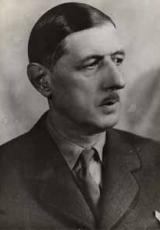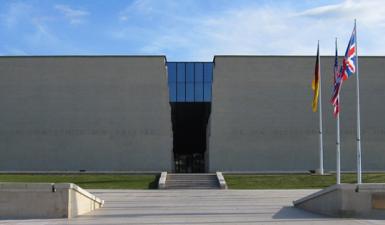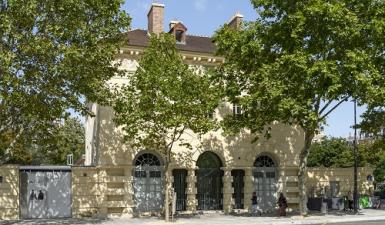The reconstruction
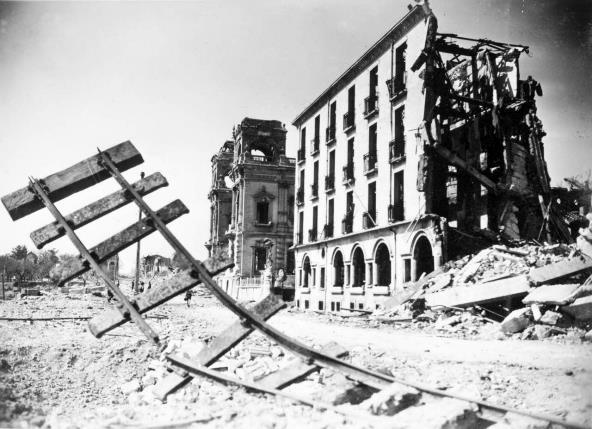
Contents
1er janvier : offensive allemande en Alsace (opération Nordwind).
2 janvier : refus du général de Gaulle de se ranger à l?ordre américain d'évacuer Strasbourg.
5 janvier : défense de Strasbourg par la 1re Armée française.
12 janvier : grande offensive soviétique en direction de Berlin.
16 janvier : nationalisation des usines Renault pour cause de collaboration.
17 janvier : libération de Varsovie.
19 janvier : condamnation à mort de Robert Brasillach, écrivain et directeur jusqu?en 1943 du journal d?extrême droite Je suis partout.
22-23 janvier : attitude légaliste de Maurice Thorez, secrétaire général du parti communiste français, à la réunion du comité central (notamment, acceptation du désarmement des milices patriotiques).
23-28 janvier : congrès du Mouvement de libération nationale.
25 janvier : condamnation à la réclusion à perpétuité de Charles Maurras, directeur du journal L?Action française se réclamant du nationalisme intégral.
27 janvier : découverte du camp d?Auschwitz par l'Armée rouge.
2 février : libération de la poche de Colmar.
4-11 février : conférence de Yalta réunissant Roosevelt, Staline et Churchill en vue d?organiser l?après-guerre.
6 février : libération d'Ensisheim . exécution de Robert Brasillach.
9 février : Colmar, dernière ville d?Alsace libérée.
13-15 février : bombardement de Dresde.
22 février : création des comités d'entreprise dans les établissements de plus de 100 employés.
3 mars : création de l?école primaire unique . création de l'Union nationale des associations familiales.
7 mars : franchissement du Rhin par les Alliés à Remagen et entrée des troupes américaines en Allemagne.
9 mars : prise de contrôle de l'Indochine française par l?armée japonaise.
20 mars : libération définitive de l'Alsace (opération Undertone).
22 mars : signature du pacte de la ligue arabe (Égypte, Syrie, Liban, Transjordanie, Irak et Arabie saoudite).
29 mars : entrée des Soviétiques en Autriche.
31 mars : franchissement du Rhin par les troupes françaises.
1er avril : débarquement des troupes américaines à Okinawa, au Japon.
9 avril : nationalisation de Gnome et Rhône pour cause de collaboration.
11 avril : libération du camp de Buchenwald, sous contrôle de ses détenus, par les Américains.
15-20 avril : libération de Royan et de la Pointe de Grave.
20-21 avril : derniers bombardements sur Berlin.
25 avril : jonction des troupes américaines et soviétique à Torgau, sur l?Elbe.
26 avril : retour de Philippe Pétain en France.
27 avril : entrée de la 1ère Armée française en Autriche.
28 avril : exécution de Mussolini par les partisans italiens.
29 avril : libération du camp de Dachau par les Américains.
29 avril-13 mai : en France, élections municipales (vote des femmes pour la première fois).
30 avril : Suicide de Hitler à Berlin.
1er-11 mai : combats et réduction des dernières poches de l?Atlantique : île d?Oléron, île de Ré, La Rochelle, Lorient et Saint-Nazaire.
2 mai : chute de Berlin . capitulation allemande en Italie.
4 mai : arrivée des Français à Berchtesgaden.
7-9 mai : capitulation sans conditions de l?Allemagne . fin de la guerre en Europe.
8 mai 1945 : massacres de Sétif et Guelma.
16 mai : la France membre permanent du Conseil de Sécurité de l'ONU.
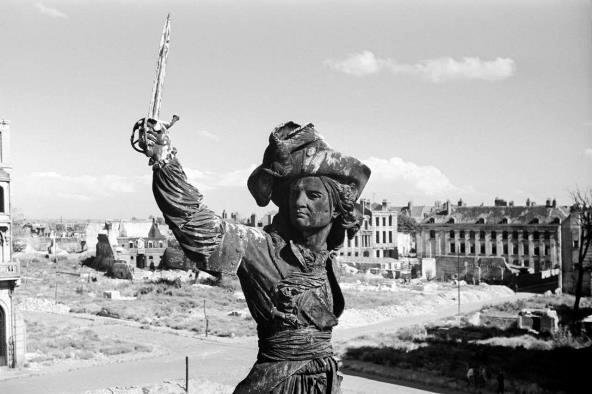
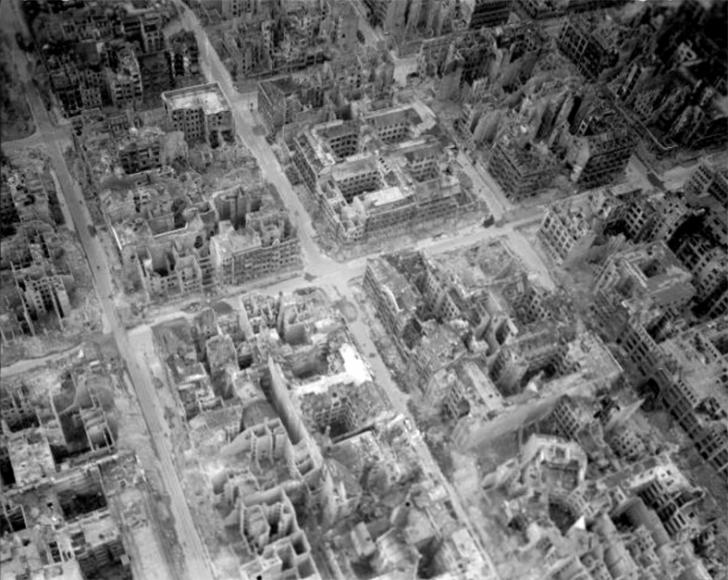
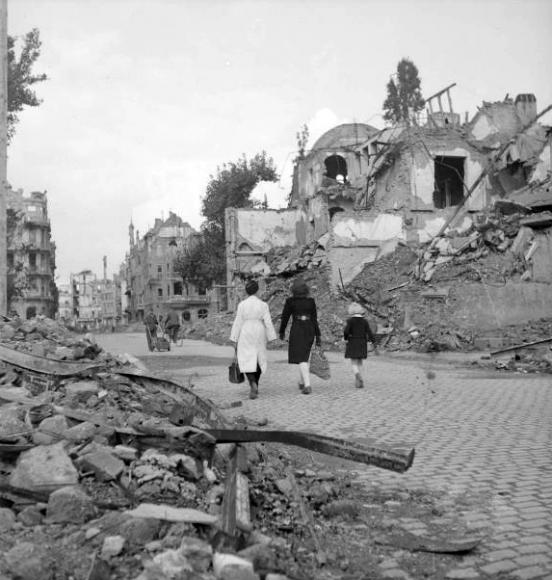
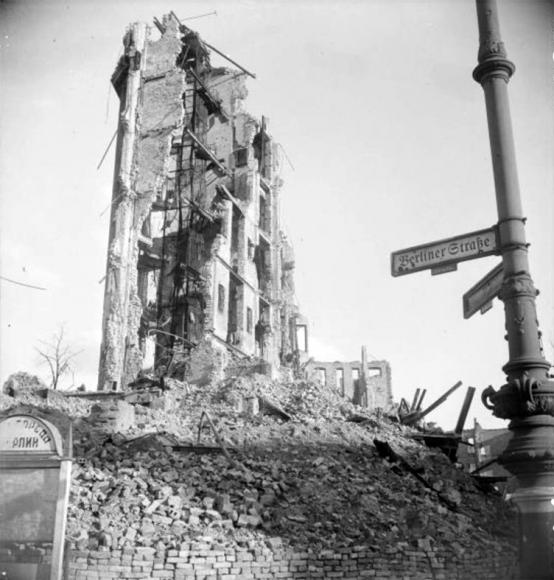
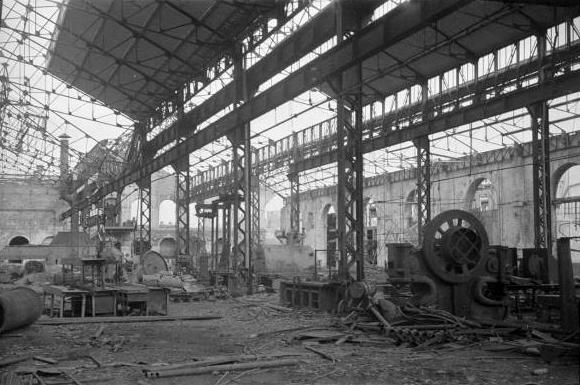
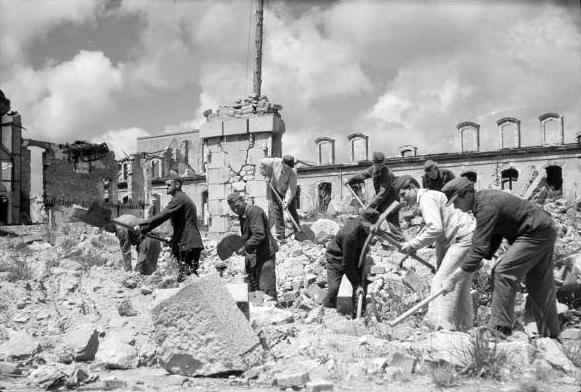
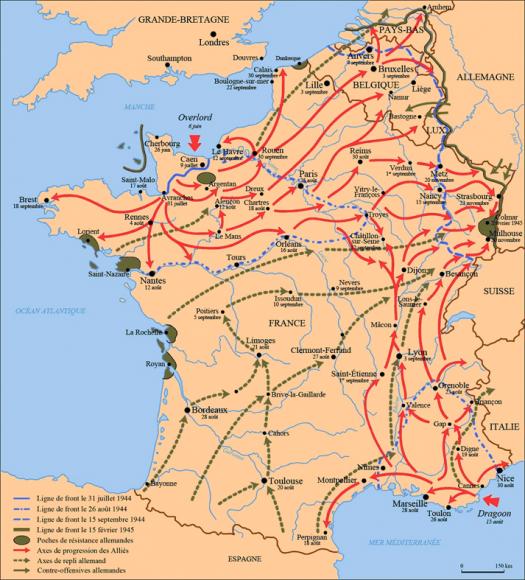
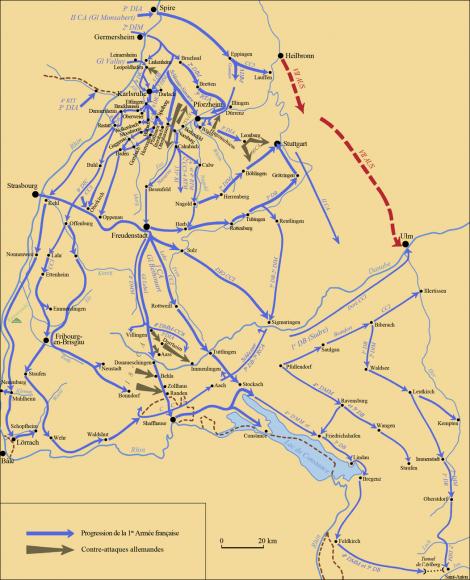
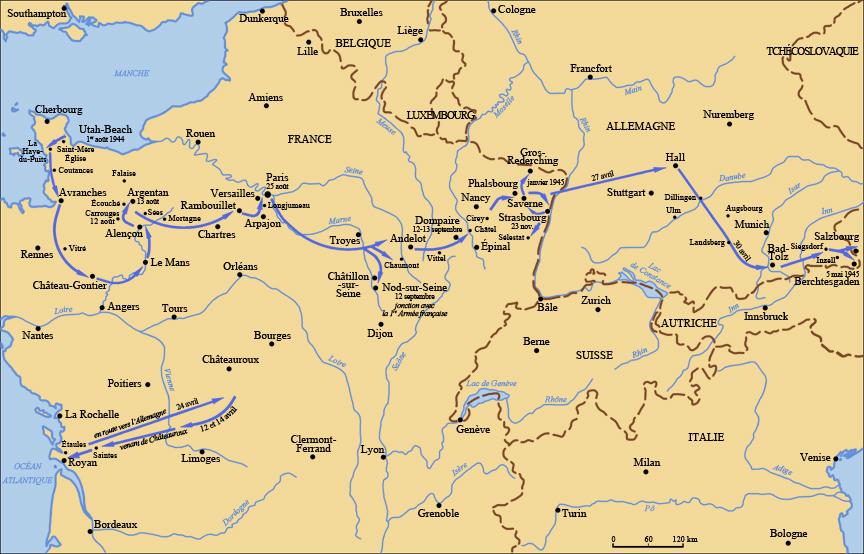
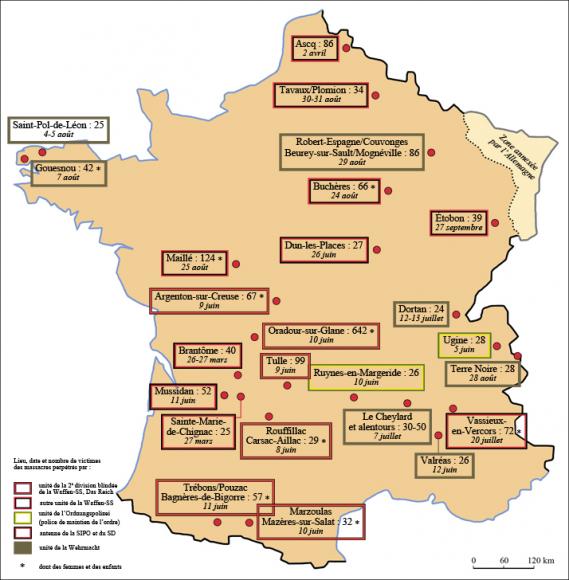
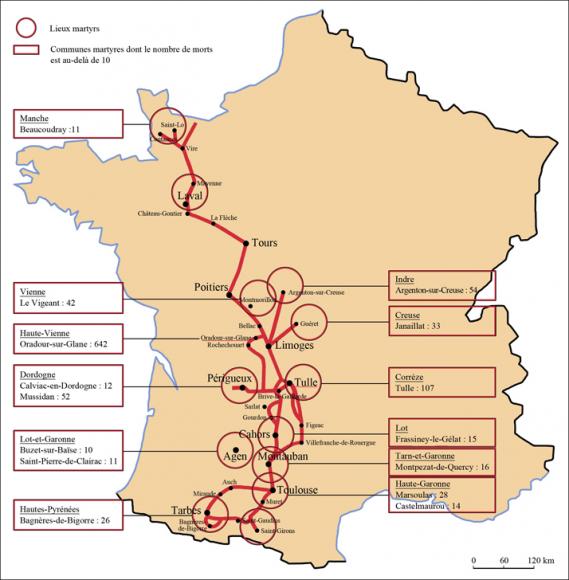
Summary
DATE : May 8, 1945
PLACE : France
FROM : Reconstruction
WAR DAMAGE : 550,000 tons of bombs dropped on France between 1939 and 1945
13 million mines left by the Germans
460,000 to 480,000 killed in acts of war
452,000 buildings totally destroyed and 1,436,000 partially destroyed
1,838 communes declared to be disaster areas
115 major railway stations and 24 marshalling yards out of 40 were destroyed
7,500 bridges collapsed
A 460 billion budget deficit over the years 1939 to 1944
Disenchantment followed the days of collective joy at the time of the Liberation. France emerged bruised and battered by years of war and occupation: high toll in human lives, cities destroyed, a devastated economy and on-going rationing. Numerous challenges were now facing the country.
For the vast majority of the French, 1944 is the year of the Liberation . With its parades and street parties, euphoria... and illusions, the summer of 1944 was one of the highlights in French history, on a part with the Fête de la Fédération in 1790, the first weeks of the Revolution in 1848 or the 11 November, 1918 . In 1944 , the present cast off the shackles of the past, the defeat in 1940 and four years of German occupation.
But in 1945, the past came back with a vengeance through a procession of disappointments and disenchantment with a future that looked anything but bright. The year 1945 could only be a let-down following on the euphoria of 1944. The time had come to look at the consequences of the conflict face on. The French had to soberly cope with the heavy heritage left by the war and the German occupation.
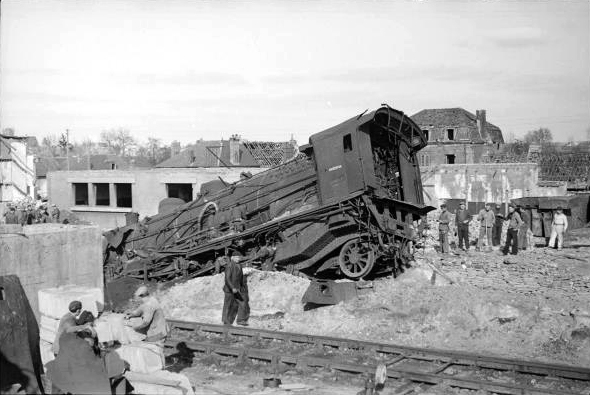
Déblaiement dans les ruines de Caen.
© ECPAD/Vincent Verdu
FRANCE OCCUPIED AND BOMBED
On two occasions, the French territory was the scene of violent clashes: in May and June 1940, at the time of the German invasion , and then from June 1944 with the fighting for the Liberation. During the four years separating those two dates, can we say the country was kept out of the conflict? Can we subscribe to the argument put forward by Pierre Laval when he exhorted his compatriots on June 6, 1944 to refuse to support the Allies who had just landed in Normandy saying: "We are not at war! " In fact, the armistice of June 1940 was not a shield protecting France from hostilities. Allied airstrikes on France continued throughout the war. With 550,000 tons of bombs (or 22% of the total), it has the sad privilege of being the most bombed country in Europe after Germany.
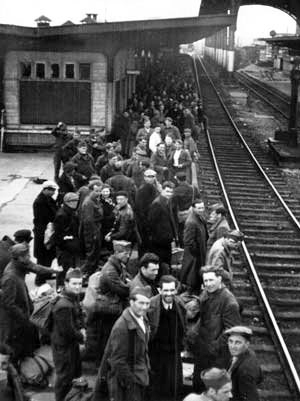
Arrivée de prisonniers de guerre français à la gare de l'Est à Paris.
© SHD
In 1940-1941, under the threat of a German invasion of England, RAF aircraft pounded the channel and Atlantic ports. In 1942-1943, when the US Air Force joined in, bombing - while continuing on the French coast - spread inland. Companies working for Germany were the prime target with such bombings as the Renault factories in Boulogne-Billancourt for example. 80% of all bombs dropped on France were dropped in 1944. As part of operation Overlord , the "transportation plan" aimed at nothing less than the destruction of the communications network, in particular the rail network . But France also felt the weight of the war through the massive German occupation in 1940 (when preparing for operation Seelöwe), an occupation which while significantly alleviated in 1942 built up again from 1943. The following year, it comprised over one million men most of them based along the coast.
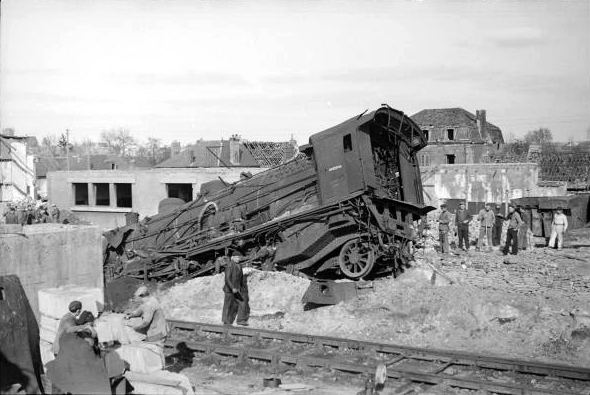
Gare ferroviaire du Mans, 1945.
© ECPAD
LOOTING AND REPRESSION
The "maintenance fees" for these troops, imposed by the winner on the loser, reached the astronomical sum of 700 billion francs for the four years. Added to this was the looting of consumer goods that German soldiers could indulge in with impunity due to the arbitrarily overvalued exchange rate of the Reichsmark. But looting took other forms: that of the most modern machines being dismantled and taken to Germany; mass requisition of horses required by a German army that was much less mechanized than is generally thought; the takeover of nearly 30% of coal production, 74% of iron ore and 50% of bauxite; requisition of meat (21%), wheat (13%), milk, butter and other foodstuffs which were eaten at the tables of German families. All this paid for... through occupation fees, i.e. by France itself. Goering had said "I intend to plunder and plunder extensively" and he did.
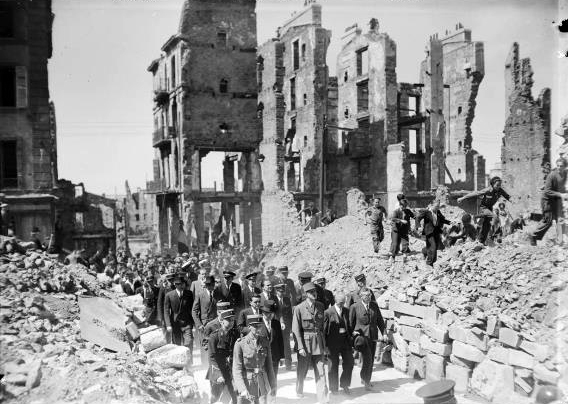
Visite du général de Gaulle en Bretagne, Brest, 26 juillet 1945.
© ECPAD/Henri Malin
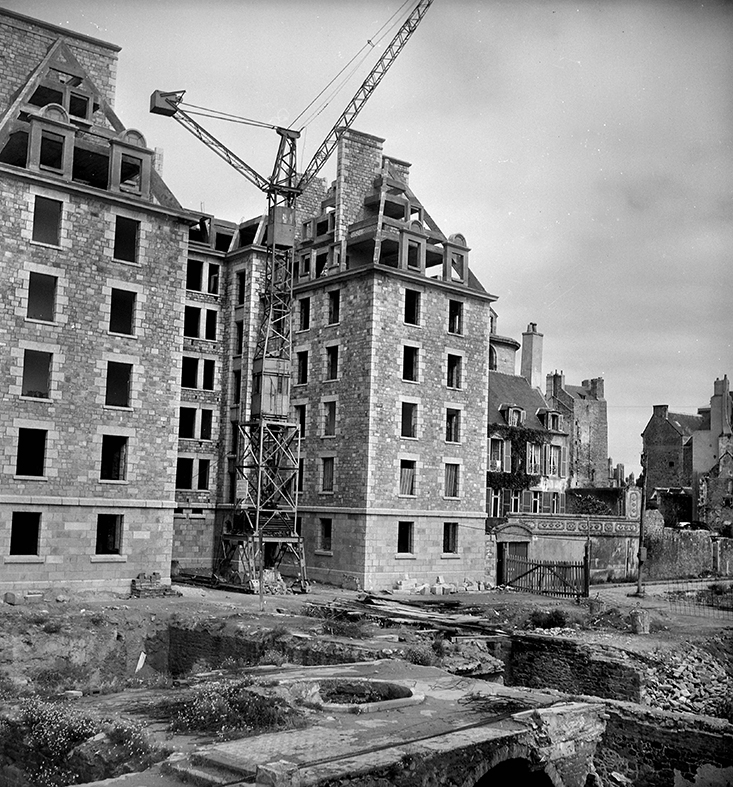
Reconstruction d'immeubles après la guerre à Saint-Malo.
© Roger-Viollet
Nor should we forget the people plundering. Due to a massive mobilisation to fight the war on several fronts, the Reich economy is short of labour. Starting in 1940, 1,500,000 French prisoners were sent to camps in Germany where many were used as labour mainly in agriculture. But needs became even more pressing with the opening of the eastern front. In France, as in other conquered countries, intense propaganda called for volunteer workers. Around 200,000 people (and not 70,000 as is often said and written) agreed to go abroad for varying durations. Among them, a fairly high proportion of foreigners and women. To meet Germany's growing needs Vichy promulgated two laws, in September 1942 (establishing compulsory labour) and February 1943 (that set up the STO, the Compulsory Work Service), which were used to send 650,000 workers to the Reich, most of them young men.
Repression was another facet of the German occupation. 90,000 men and women were deported to concentration camps. These were members of resistance organisations (44%) or people arrested for acts of refusal or even hostility towards occupying forces (29%). The remainder (27%) were hostage, people rounded up, common law prisoners, former Communists... At the same time, the Nazi persecution hit 75,000 Jews, mostly of foreign origin, and mainly sent to Auschwitz-Birkenau. Those who were deemed capable of working were sent to factories or workshops as were concentration camp inmates. The number of men shot was around 4,000 (a figure greatly overestimated for a very long time). While civilians in northern France suffered atrocities by German troops (especially the SS) from 1940 on, summary executions in France disappeared until February 1944 when the Sperrle decree allowed the introduction in western France of those expedient methods already in force on the eastern front to combat resistance fighters and civilians. It actually opened the way for appalling atrocities by specifying that the perpetrators would not be condemned: "No sanction will result from excessive severity in the measures taken". The first massacres struck the maquisards in the Alps and Massif Central regions as well as civilians suspected of assisting them but also the inhabitants of Ascq in the North , following a sabotage operation.
After the Normandy Landing this atrocious logic continued to be followed with the killings in Tulle , Oradour-sur-Glane Argenton, Buchères, Mesh committed by various SS units...
With the exception of Alsace and the "Atlantic pockets", the bulk of French territory was liberated in Autumn 1944. But in what state ?
HIGH TOLL IN HUMAN LIVES
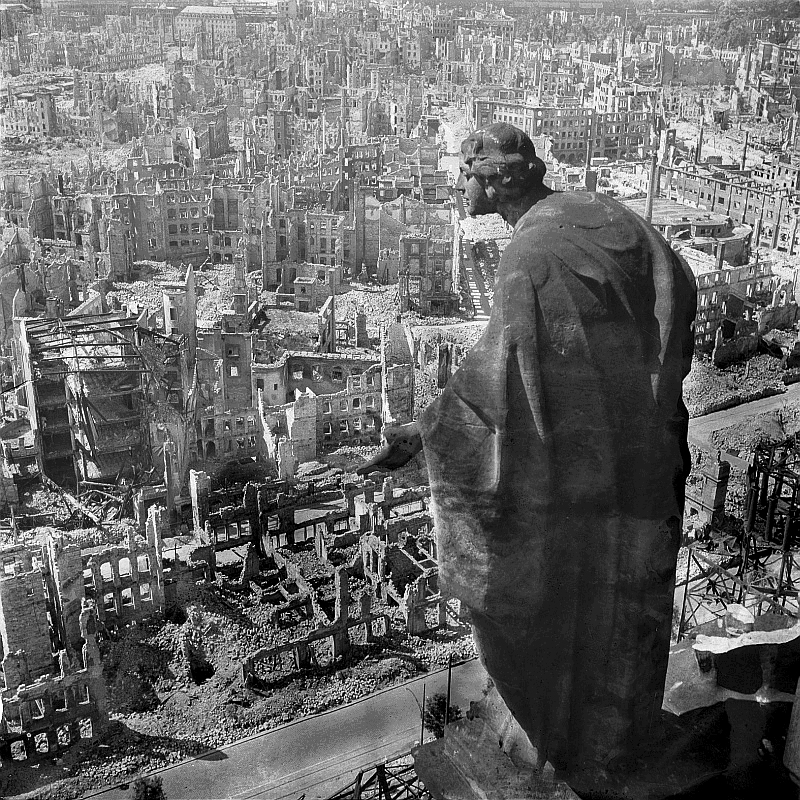
Dresde en 1945.
© Richard Peter/Deutsche Fotothek
The number of people killed by acts of war between 1939 and 1945 was between 460,000 and 480,000, i.e. significantly lower than the estimate put forward at the end of the 1940s by the Damages and Reparations Commission (600 000). It is incommensurate with the carnage of the first world war, but on a par with the losses suffered by the United Kingdom (400,000) or Italy (440,000). The other difference with the Great War is the roughly equal breakdown between military and civilian losses reflecting in fact the human toll taken by World War II as a whole.
Between 55,000 and 65,000 men lost their lives during the fighting in May and June 1940 and not the widely believed 100,000 figure that is belied by the database established by the Ministry of Defence. The difference comes from the confusion, maintained deliberately or not, that came from adding the dead in the 'phoney war' (more than 10,000) and the 30,000 to 40,000 prisoners of war captured in 1940 but who did not die until later in Germany, to the number of dead in the spring of 1940. The main additions to this were the losses by the Vichy army in Syria, North Africa... (4,300), those of Free France (3,200) and finally those of the French army reconstituted in 1943 and engaged in Tunisia and Italy then, in the Liberation of France and the final assault against Germany, i.e. a total of 23,000 soldiers, to which must be added the 14,000 FFI killed in battle or summarily executed in France. Nor should we forget the 32,500 soldiers from Alsace-Moselle who died fighting for Germany. Civilian casualties are due both to the Germans, the allies... and incidentally to the French. Repression and persecution by the Nazis were responsible for the disappearance of close to 4,000 hostages and persons sentenced to be executed by firing squad, 36,000 deportees who died in concentration camps, over 70,000 Jews and 10 to 15,000 civilian victims of summary executions and deliberate massacres. In addition to this total are the civilian workers, both requisitioned and voluntary, who died in Germany: 60,000? 40,000? We still do not know. The number of deaths during allied air bombings is estimated at between 50 and 70,000. Finally, 'wild' purging after the Liberation resulted in the death of approximately 9,000 individuals accused of being collaborators.
MASSIVE MATERIAL DESTRUCTION
Between 1939 and 1945, France suffered material destruction much greater than that of the first world war. Of course, 13 departments had been totally devastated but the rest of the country had not suffered any damage. Between 1940 and 1945, the territory had to cope with two ferocious campaigns. The impact of the 1940 campaign was mainly felt in the North of France; the 1944 campaign ravaged Normandy and to a lesser extent Provence, but also the East; between these two campaigns allied air bombing spared very few regions. In all 74 departments were hit.
The most visible destruction concerned property: 452,000 buildings were completely destroyed (twice as many as in the United Kingdom) and 1,436,000 were partially damaged. Close to 20% of buildings in the country were concerned, compared to 10% in the first world war. There were a million homeless families, i.e. 4 to 5 million people; giving rise to a severe housing crisis. In 1946, the Damages and Reparations Commission estimated the cost of a return to normal at some 5,000 billion, i.e. two to three years of national income. 1,838 communes were declared to be disaster areas. Among them, 15 of the 17 cities with more than 100,000 inhabitants. 21 of the 39 having between 50,000 to 100,000. But rural areas suffered just as much: a quarter of the communes hit had fewer than 2,000 inhabitants. The more severely hit department, Calvados, had 120,000 buildings destroyed. In
1945, transportation systems were largely paralysed due to the massive destruction that left a fragmented France in its wake. The rail network in particular suffered from being requisitioned by the Germans, attacked by the Resistance and bombed by the Allies: half of the railway lines were out of service for a more or less long period; 115 major stations were destroyed along with 24 of the 40 marshalling yards; close to 2,000 structures (bridges, tunnels, viaducts) were unusable. The SNCF only had one out of two passenger wagons in working order, and only one out of three freight cars and one out of six locomotives. Road transport was no better off with 7,500 bridges and four-fifths of all trucks destroyed. Inland waterway transport and especially the ports also suffered from 4 years of bombing by the RAF. Huge numbers of electricity pylons were destroyed and 90,000 kilometers of telephone lines were out of service.
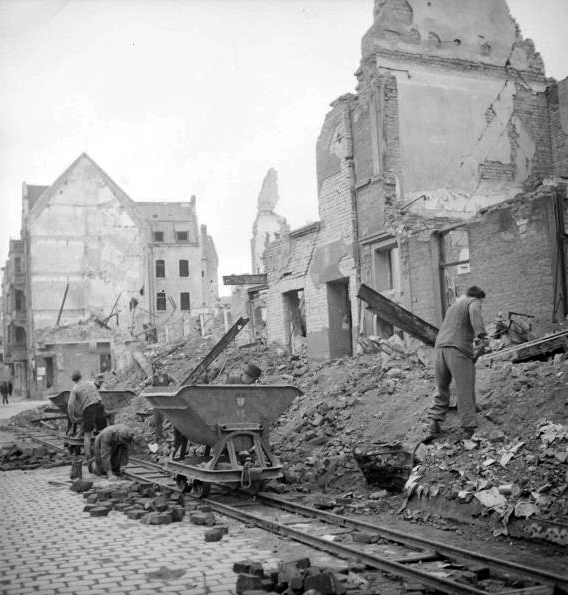
Ruines de Coblence, les ouvriers du STO occupés à déblayer les rues.
© ECPAD/André Gadner
A DEVASTATED ECONOMY
The war and the Occupation were terrible blows to a French economy already weakened by the crisis of the 1930s. Even in the form of cold statistics, the figures are shocking. During the war, agricultural production declined by 40%. In 1945, the wheat harvest only amounted to 42 million quintals compared to 73 in 1939; the potato harvest dropped from 144 to 61 million quintals; there was only half as much meat available in the shops. The reason for this was the 3 million drop in the number of hectares being cultivated; stretches of land infested with the 13 million mines left by the Germans; the disappearance of one third of work horses, requisitioned by the Germans; the shortage of fertilizer, a fatal blow to crop yields, but also that the shortage of labour with numerous fields lying idle.
The drop in industrial production was even more impressive: 60 per cent down on 1938 and even 70% down on its level in 1929. In 1945, the coal mines provided over 25 million tonnes compared to 47 million before the war; the steel industry just 1.6 million tonnes compared to 6.2 million and cement factories just 126,000 tonnes compared to 296,000. Everything combined to explain this collapse: the bombing of the factories, plundering of machines, raw materials and workers by Germany, power and raw material supply difficulties... As for the recovery, it was difficult in 1945 given the two bottlenecks that were the destruction of transportation systems and the shortage of coal, the essential energy source at the time.
The collapse in production caused a serious drop in supply compared to demand and inevitably a sharp rise in prices and wages. Taxed prices were multiplied by three between 1938 and 1944; all prices (including therefore the black market) were multiplied by five. Already present under Vichy, inflation became rampant after the Liberation and was a recurring evil under the Fourth Republic. Under these conditions, the franc depreciated strongly against the dollar. Production shortcomings also hit foreign trade with huge falls in exports while imports climbed sharply to meet the needs of the economy and the population.
In 1945, imports were five times higher than exports. To finance these imports, France lived on credit. Public finances themselves were at risk with a colossal budget deficit estimated at 460 billion for the years 1939 to 1944. That year, tax revenues only covered 30% of expenditure and a little more than 55% in 1945. To cope with this situation, government borrowing soared. The debt was multiplied by four during the six years of the war.
While the French man in the street was not necessarily conscious of the huge economic and financial problems, he was however brutally confronted with some of their consequences and, first and foremost, the ongoing food and other supply shortages. This essential issue during the entire Occupation did not disappear at the Liberation, on the contrary. A certain resignation gave way to stupor and utter incomprehension. Many felt that with the departure of the Germans, who were "taking everything" in the words of Radio London, surely the country should return to its former abundance and prosperity. But rationing remained in force. The infamous rationing tickets were still there as were the queues for the shops and a black market that was more flourishing than ever. In fact the production and distribution systems suffered so much during the Occupation that it was impossible to wipe out four years of disruptions and a parallel economy overnight. Restrictions therefore continued. Dinner plates were far from full; gas and electricity were still distributed sparingly. Rationing was to continue until 1949. Surveys conducted by IFOP showed that the most pressing concern for the French remained procuring supplies.
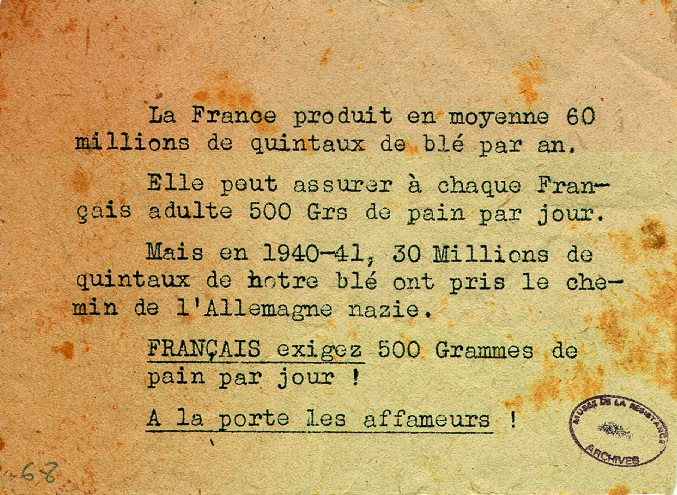
Papillon anti-allemand. La question du ravitaillement devient un sujet de préoccupation quotidien alors que les Allemands prélèvent à leur profit 40 % et plus de la production.
© Musée de la Résistance nationale – Champigny
THE ROAD TO RECOVERY
In the spring of 1945, the "absent" began to return: two million men and a few thousand women: prisoners of war voluntary or requisitioned workers deportees . Some came back to families that could have changed, especially the children. They have grown up and have few if any memories of this prodigal father. All discover a country that does not necessarily resemble the one they had left. A terribly scarred country!
Yet the war and the Occupation, despite great tragedy, also laid the foundations for a revival. Thus, the increase from 1943 in the birth rate ushered in the famous "Baby Boom" that had been called for by de Gaulle : "We need ten million beautiful babies in ten years"; and this put a sudden stop to the ageing of the French population as well as being one of the driving forces behind the future "thirty glorious years".
The material destruction caused by the war was at the origin of an episode known in French history as the 'Reconstruction'. In reality, it would be more accurate to talk of a "re-urbanisation" that was not content to just reproduce the destroyed cities in the same way, but which imagined them as being more coherent, more spacious with dilapidated and unsanitary neighbourhoods being replaced by buildings with all modern comfort. In another area, the French State - in reaction to the need - expanded its scope of economic intervention thus preparing public opinion for the major reforms in this area by the Provisional Government , then by the Fourth Republic.
The Resistance, meanwhile, while continuing the fight against the occupier and Vichy, initiated in-depth reflections on what the new France should be like after the war. It was in this spirit that the famous programme of the National Council of the Resistance was adopted in March 1944 and which called for numerous reforms in the economic and social sphere. It was to serve as a "handbook" for French governments after the Liberation. In 1945, the future is still not bright but at least there is a spark of light at the end of the tunnel.
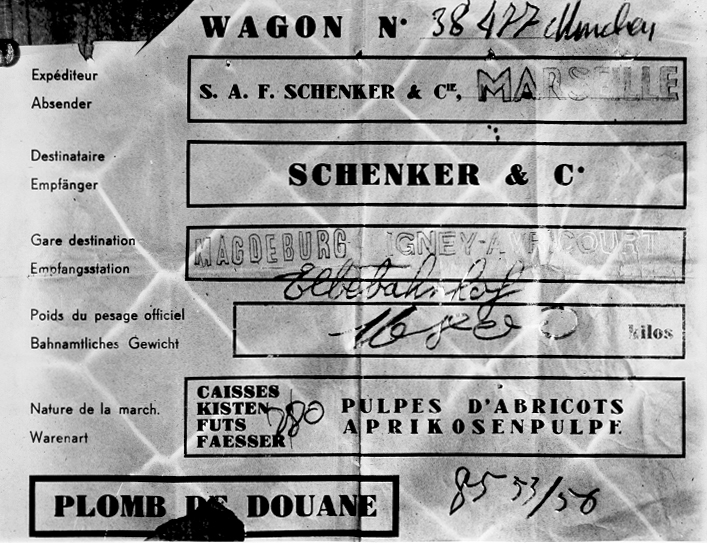
Tous les produits, absolument tous, intéressent les Allemands… Étiquette placée sur le wagon d'expédition vers l'Allemagne.
© SHD
Author
Jacques Quellien - University of Caen - Lower Normandy
Read more
Bibliography :
La Seconde Guerre mondiale, Jean Quellien, Tallandier, 2015.
La reconstruction des villes françaises de 1940 à 1954, histoire d'une politique, Danièle Voldman, L'Harmattan, 1997.
Articles of the review
-
The event
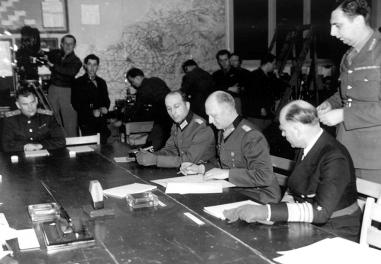
Reims, May 7, 1945. The German surrender
Read more -
The figure

The Red Army: final offensives
From the defence of Moscow to the victories of Stalingrad and Kursk, from Smolensk to the Black Sea, from the Vistula to the Oder, to the march into Berlin..., the great patriotic war conducted by the Red Army sealed the fate of the Reich heralding the emergence of a new superpower.
Read more -
The interview
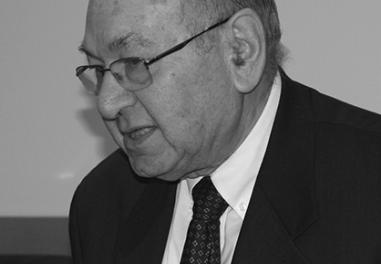
Serge Berstein
Former teacher at the IEP in Paris, this specialist in the political history of contemporary France looks back at the nature of the Vichy regime and sheds light on the political and institutional choices that were available to the French after the Liberation.
Read more


